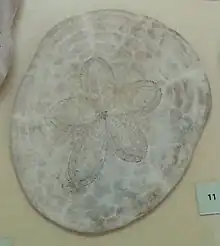| Clypeaster subdepressus | |
|---|---|
 | |
| Scientific classification | |
| Domain: | Eukaryota |
| Kingdom: | Animalia |
| Phylum: | Echinodermata |
| Class: | Echinoidea |
| Order: | Clypeasteroida |
| Family: | Clypeasteridae |
| Genus: | Clypeaster |
| Species: | C. subdepressus |
| Binomial name | |
| Clypeaster subdepressus | |
| Synonyms[1] | |
| |

Specimen preserved in the National Museum of Brazil.
Clypeaster subdepressus is a species of sea urchin in the family Clypeasteridae. This species was first scientifically described in 1825 by the British zoologist John Edward Gray.[1] It is a very large and flattened sea biscuit, native to the east coasts of North, Central and South America.
Distribution
This species is found in shallow water in the tropical and subtropical western Atlantic Ocean. Its range extends from North Carolina southwards to the Caribbean Sea, Central and South America, as far south as Rio de Janeiro in Brazil.[2]
References
- 1 2 3 Kroh, Andreas (2018). "Clypeaster subdepressus (Gray, 1825)". WoRMS. World Register of Marine Species. Retrieved 4 June 2018.
- ↑ Schultz, Heinke A.G. (2017). Echinoidea: with bilateral symmetry. Irregularia. De Gruyter. pp. 63–64. ISBN 978-3-11-036853-6.
External links
![]() Media related to Clypeaster subdepressus at Wikimedia Commons
Media related to Clypeaster subdepressus at Wikimedia Commons
This article is issued from Wikipedia. The text is licensed under Creative Commons - Attribution - Sharealike. Additional terms may apply for the media files.